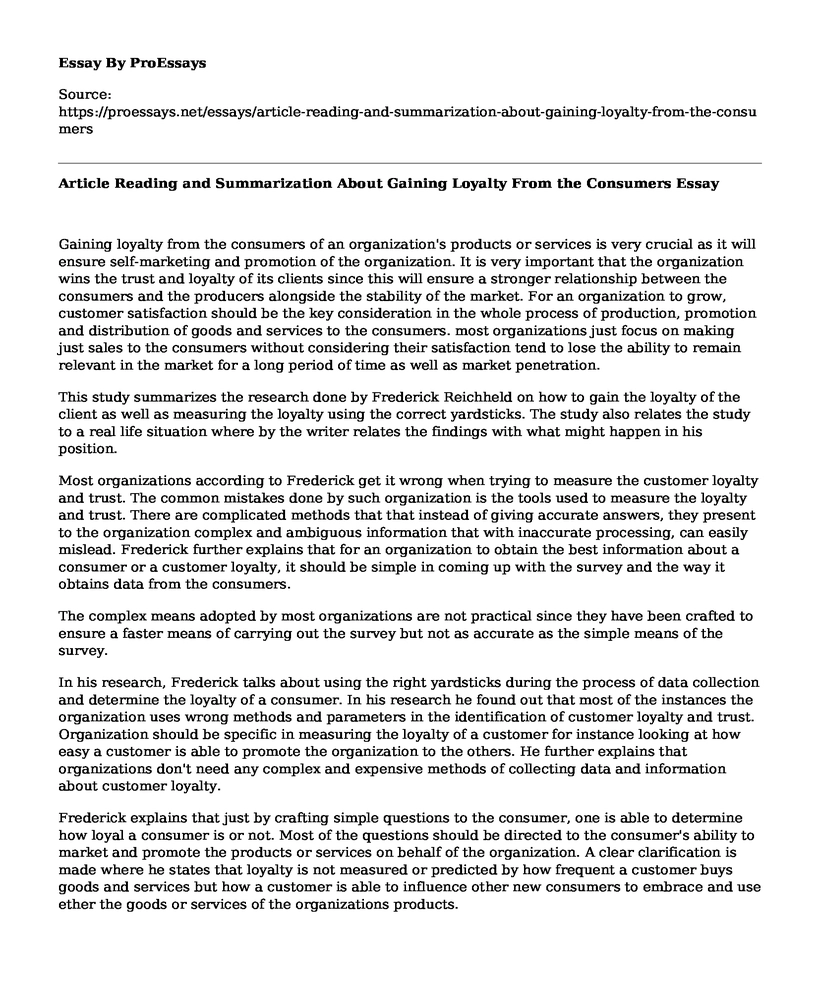Gaining loyalty from the consumers of an organization's products or services is very crucial as it will ensure self-marketing and promotion of the organization. It is very important that the organization wins the trust and loyalty of its clients since this will ensure a stronger relationship between the consumers and the producers alongside the stability of the market. For an organization to grow, customer satisfaction should be the key consideration in the whole process of production, promotion and distribution of goods and services to the consumers. most organizations just focus on making just sales to the consumers without considering their satisfaction tend to lose the ability to remain relevant in the market for a long period of time as well as market penetration.
This study summarizes the research done by Frederick Reichheld on how to gain the loyalty of the client as well as measuring the loyalty using the correct yardsticks. The study also relates the study to a real life situation where by the writer relates the findings with what might happen in his position.
Most organizations according to Frederick get it wrong when trying to measure the customer loyalty and trust. The common mistakes done by such organization is the tools used to measure the loyalty and trust. There are complicated methods that that instead of giving accurate answers, they present to the organization complex and ambiguous information that with inaccurate processing, can easily mislead. Frederick further explains that for an organization to obtain the best information about a consumer or a customer loyalty, it should be simple in coming up with the survey and the way it obtains data from the consumers.
The complex means adopted by most organizations are not practical since they have been crafted to ensure a faster means of carrying out the survey but not as accurate as the simple means of the survey.
In his research, Frederick talks about using the right yardsticks during the process of data collection and determine the loyalty of a consumer. In his research he found out that most of the instances the organization uses wrong methods and parameters in the identification of customer loyalty and trust. Organization should be specific in measuring the loyalty of a customer for instance looking at how easy a customer is able to promote the organization to the others. He further explains that organizations don't need any complex and expensive methods of collecting data and information about customer loyalty.
Frederick explains that just by crafting simple questions to the consumer, one is able to determine how loyal a consumer is or not. Most of the questions should be directed to the consumer's ability to market and promote the products or services on behalf of the organization. A clear clarification is made where he states that loyalty is not measured or predicted by how frequent a customer buys goods and services but how a customer is able to influence other new consumers to embrace and use ether the goods or services of the organizations products.
By calculating the net promoter score, Frederick explains how an organization is able to estimate the number of promoters of the organization's goods and services as well as the organization's detractors. By categorizing the consumers in ratios for instance, satisfied, passively satisfied and destructors is a clear way of identifying is either a consumer is a promoter or a detractor. It is therefore very easy for an organization to estimate the consumer loyalty by looking at how the consumer is able to convince other new consumers to use the organization's products or services. Organizations therefore should therefore use such parameters and yardsticks to identify the loyalty and trust.
Relating this research in a real life situation, for instance, looking at a company producing food products. Depending on how easy the food product is able to satisfy the consumer needs, it will be very easy for the organization to gain loyalty and strong base foundation in the market. The company, however, cannot judge the loyalty of the consumers by looking at how frequent they buy the products. This might be because the consumers just lack a better alternative thus their frequency of use of the company's food products. If the consumers of this food product are able to inform other people for example family members, colleagues and friends about the food product, it will be a clear indication that indeed the consumers are loyal and are able to risk their reputation by making known to others the kind of products they consume. This food product company therefore should look at some parameters like promotion of the product by the consumers but not the frequency of use of the products in order to judge the loyalty and trust.
According to Frederick, organization such as the above food product company when trying to identify the consumers' loyalty, it should consider asking the right questions to the right kind of consumers. Most organizations ask some kinds of questions to consumers that might not be of important collection of relevant data to measure the loyalty and trust of the consumers.
Cite this page
Article Reading and Summarization About Gaining Loyalty From the Consumers. (2022, May 09). Retrieved from https://proessays.net/essays/article-reading-and-summarization-about-gaining-loyalty-from-the-consumers
If you are the original author of this essay and no longer wish to have it published on the ProEssays website, please click below to request its removal:
- Case Review Example: 23andMe Genetic Testing for Consumers
- Sources of Competitive Advantage of SodaStream
- The Influence of the FIFA 2018 on the Quality of Service Offered in Russia Paper Example
- Organizational Budgeting: Outlining Financial Goals & Allocating Resources - Essay Sample
- An In-Depth Look Into Skywalker's Streaming Options: Netflix vs Amazon Prime Video - Essay Sample
- Organizational Effectiveness in Networked Economy: Conversations Matter - Essay Sample
- Warren Buffett's New Letter: A Closer Look - Free Paper Example







